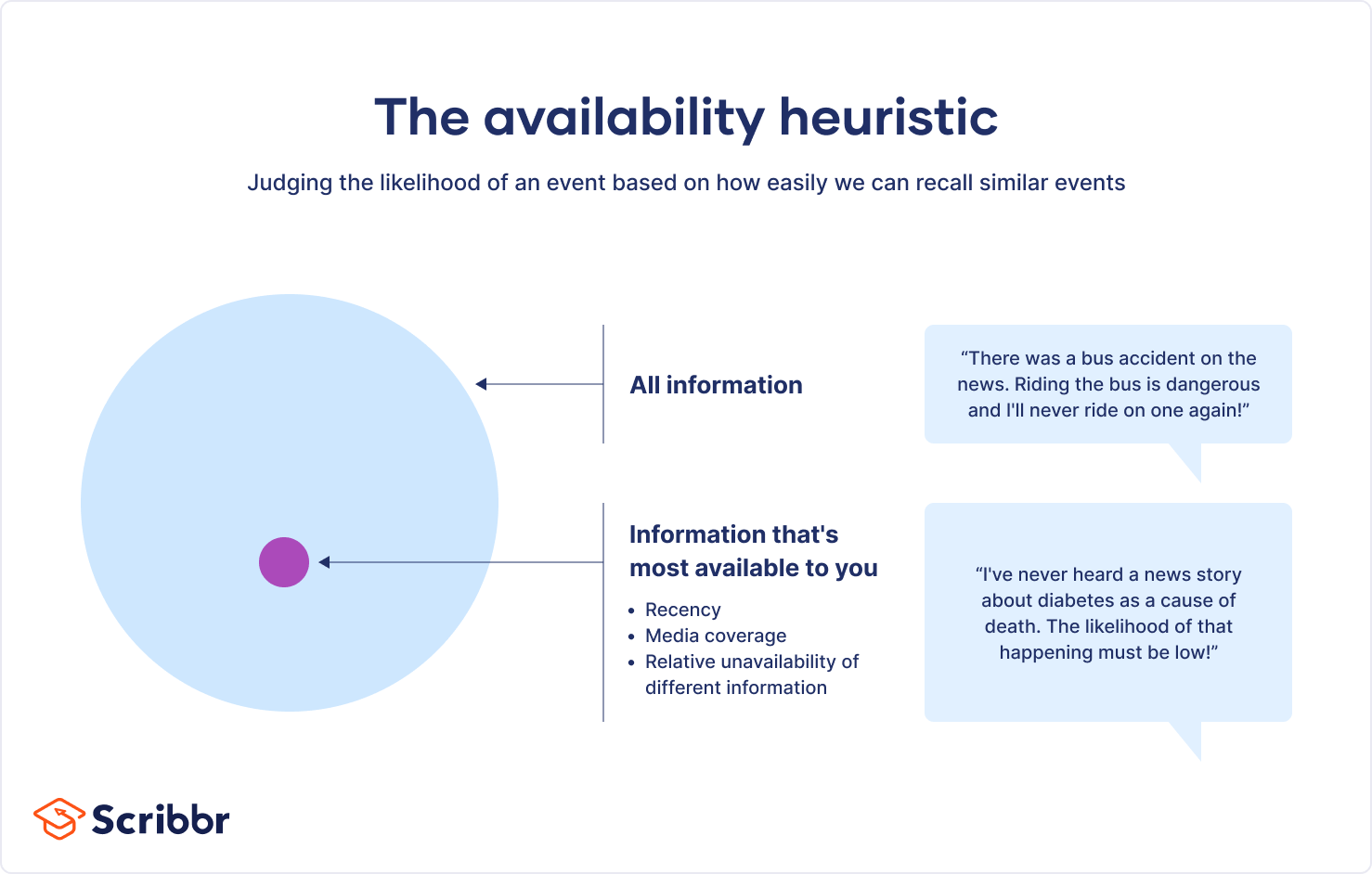The Availability Heuristic | Example & Definition
The availability heuristic occurs when we judge the likelihood of an event based on how easily we can recall similar events. If we can vividly remember instances of that event, we deem it to be more common than it actually is.
People overestimate the risk of shark attacks because there are far more news stories and movies about them. As a result, images of shark attacks are easier to bring to mind. If you can quickly think of multiple examples of something happening, then you are tricked into thinking it must happen often.
Due to the availability heuristic, our perception of reality can be distorted. This can lead to poor decision-making (especially when assessing risks) and to a few types of research bias, including recall bias.
Table of contents
What is a heuristic in psychology?
In psychology, a heuristic is a mental shortcut or rule of thumb that people use to make decisions.
In general, mental shortcuts are helpful because they allow us to reach a conclusion or make a choice quickly. If we had to factor in every piece of information when making everyday choices, we would spend far too much time trying to find the best possible answer.
While heuristics are helpful, they can also lead to biased decision-making and sub-optimal choices.
What is the availability heuristic?
The availability heuristic (or availability bias) is a type of cognitive bias that helps us make fast, but sometimes incorrect, assessments. It involves relying on information that comes to mind quickly or is most available to us.
Under the availability heuristic, information that is more easily recalled is assumed to reflect more frequent or more probable events. Conversely, information that is more difficult to recall is assumed to reflect less frequent or less probable events. As a result, the availability heuristic influences our perception of reality.
Availability heuristic vs representativeness heuristic
The availability heuristic and the representativeness heuristic are both mental shortcuts we rely on when assessing the probability or frequency of something happening. Although they are often confused, they are different types of heuristics.
The availability heuristic makes us estimate the likelihood of an event based on our ability to recall similar events, while the representativeness heuristic makes us estimate the probability of something based on the degree to which it resembles (or is representative of) a known situation. However, this can lead us to a wrong conclusion, because the fact that something is more representative does not actually make it more likely.
For example, people with tattoos are often stigmatised and perceived as less professional in job interview settings. Under the representativeness heuristic, a hiring manager might perceive a candidate with tattoos as unsuited for the job.
Why does the availability heuristic occur?
The availability heuristic occurs because some events are easier to recall than others. The easier something is to recall, the more likely it is to influence your opinions and decisions, because availability is mistaken for frequency. There are a number of reasons why something is more readily available to us:
- Media coverage: dramatic events are more likely to feature in the news. For example, plane crashes, natural disasters, or gruesome crimes are all headline-grabbers. Because of this, we are often exposed to vivid images or descriptions of events that leave a lasting impression on us. As a result, we overestimate their frequency or probability.
- Recency: events that have taken place recently are inherently easier to remember, especially if they were dramatic, emotionally charged, or impactful. Due to this, they are more likely to influence our decision-making.
- The relative unavailability of information: some high frequency but less-publicised causes of death (e.g., diabetes) lead people to believe that those kinds of events are less probable than they really are.
Availability heuristic examples
The availability heuristic leads us to rely on current or easily recalled information instead of processing all relevant information when faced with a choice.
If you recently saw a car tumble off the side of the road, you would probably think that traveling by car is riskier than traveling by plane. However, if you recently watched a movie about a plane crash, you might feel that planes are more dangerous. Something that we recently saw is more easily remembered and likely to affect our judgement.
The availability heuristic can also lead to biased judgements when examples of one event are inherently more difficult to generate than examples of another.
However, most people find it easier to think of words beginning with ‘k’ and therefore would conclude that it’s more likely that the sampled word starts with ‘k’. In reality, a typical text contains twice as many words in which ‘k’ is in the third position than words starting with that letter.
The availability heuristic causes us to reach a biased conclusion. In general, people are better at retrieving words from memory using the word’s initial letter than a letter in a random position.
Other types of research bias
Frequently asked questions about the availability heuristic
Sources for this article
We strongly encourage students to use sources in their work. You can cite our article (APA Style) or take a deep dive into the articles below.
This Scribbr articleNikolopoulou, K. (2023, March 06). The Availability Heuristic | Example & Definition. Scribbr. Retrieved 2 July 2025, from https://www.scribbr.co.uk/bias-in-research/availability-bias/
Michel-Kerjan, E., Forges, S. L., & Kunreuther, H. (2012). Policy Tenure Under the U.S. National Flood Insurance Program (NFIP). Risk Analysis, 32(4), 644-658. https://doi.org/10.1111/j.1539-6924.2011.01671.x
Plous, S. (1993). The psychology of judgment and decision making. Mcgraw-Hill Book Company.

